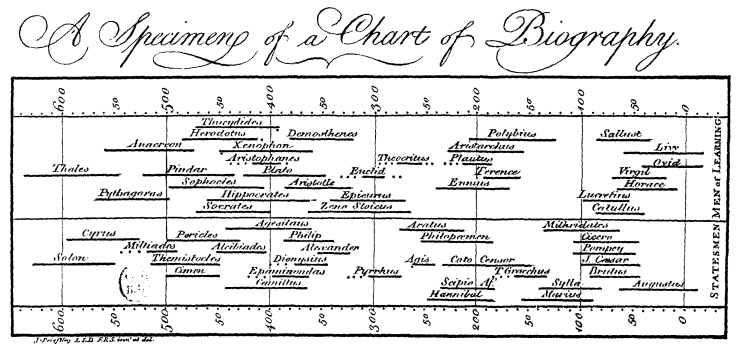A brief history of project scheduling
Modern schedule control tools can trace their origins to 1765. The originator of the ‘bar chart’ appears to be Joseph Priestley (1733-1804); his ‘Chart of Biography’ plotted some 2,000 famous lifetimes on a time scaled chart: “…a longer or a shorter space of time may be most commodiously and advantageously represented by a longer or a shorter line.”

Priestley’s ideas were picked up by William Playfair (1759-1823) in his Commercial and Political Atlas of 1786. Playfair is credited with developing a range of statistical charts including the line, bar (histogram), and pie charts. The atlas contained 43 time-series plots and one histogram.

Following on from Playfair another European, Karol Adamiecki, a Polish management researcher, developed the Harmonogram, also known as the Harmonygraph in 1896. The time-phasing and duration of the activities is shown by a vertical sliding tab, essentially the same as a bar in a bar chart. Of greater significance, the Harmonygraph also tabulates each activities predecessors and successors (‘from’ and ‘to’) making it a distinct predecessor to the CPM and PERT systems developed some 60 years later.
Henry Gantt, popularised the bar chart (Gantt Chart) in the USA through his books published in the early 20th century.
Other techniques dating from the early part of the 20th century include Line of Balance (flow line) used on the Empire State Building in the 1930s and Milestone charts, which were in regular use by the 1950s.
The key problem with Milestones and bar charts is all of the dates and durations are based on heuristics (rules of thumb) and/or experience. It was possible to identify slippage, but any assessment of the impact of a delay was based on a personal view of the data rather than analysis. As a consequence, when schedule slippage became apparent on major contracts, the tendency was to flood the work with labour and ‘buy’ time, frequently at a high premium.
The key value contributed by CPM and PERT systems was the ability to model future outcomes based on progress to date and optimise the use of scarce resources.
Scheduling evolution
The evolution of scheduling has been a fascinating journey:
- Kelley and Walker set out to solve the time-cost conundrum and invented CPM: for most organisations the resolution of time-cost issues is still in the ‘too hard’ basket!
- The PERT project invented the name ‘Critical Path’, and everyone else borrowed it.
- Dr John Fondahl invented a non-computer methodology for scheduling that is now used by every computer package worldwide.
- And while Kelley and Walker’s CPM system was developed for computers, it is now primarily seen as a manual technique.
For a more comprehensive history of project scheduling, see Pat Weaver’s ever-evolving paper: Mosaic Projects > A Brief History of Scheduling—Back to the Future

